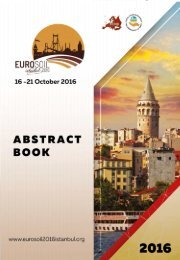z kara-f ates- a sbır
Create successful ePaper yourself
Turn your PDF publications into a flip-book with our unique Google optimized e-Paper software.
Zeki KARA, Fadime ATES, Ali SABIR<br />
Materials and methods<br />
This research was held in MVRI Turkey during the 2008 vegetation periods in Manisa province. Manisa is<br />
located at 71 m above sea level, and 38˚36” East and 27˚24” North hemisphere. According to the climatic<br />
records of state meteorology station, in vegetation period the day number with the average temperature<br />
above 10 ⁰C was 271, from 27th February to 23rd November 2008. Mean temperature was 21.5 ⁰C, and the<br />
sum of effective temperature was 2880.3 ⁰C. Annual precipitation was 480 mm, and relative humidity was<br />
60.5.<br />
SC was used by two different cultivation techniques as raisin (SC r) and table grape SC tg) production<br />
purpose which was used for understanding the differences of selected clones as S, S4, S5 and S6.<br />
Samples were collected during ripening period by a week intervals and at local harvest tame for determine<br />
the varietal and cultivation differences. Samples were collected during ripening period from 08,07,2008 to<br />
06,08,2008 for each analyze.<br />
In the field, yield (kg vine-1) was determined by weighting all the clusters on 10 vines and mean cluster<br />
weight were determined by using 10 clusters for each clone. Cluster numbers (n) was determined by<br />
observing all clusters on 10 vines for each grape genotype.<br />
In the laboratory, berry weight (g bery-1) was determined by 100 berries collected from 10 clusters. Berry<br />
shape index (l/w) was calculated by 100 berries collected from 10 clusters. Soluble solids of must (⁰Brix)<br />
analyzed by hand refractometer (Atago 9313), PH was determined by pH meter. Titration acidity (tartaric<br />
acid) was analyzed by titration method (Anonymous 1997). P-value was tested in sample juices by the Bio-<br />
Electronical Terrain-Analysis (BE-T-A) from MED Tronic MT 732-Full-Microprocessor-Controlled System<br />
(Heinrich and Rey, 1997).Berry color was determined by cromometer (Konica Minolta CR400 with the<br />
Hunter scale, L, a, b; McGuire 1992).<br />
The researches were designed as 3 replicated randomized parcels. Data were analyzed using SPSS for<br />
Windows 12.1, and graphs were performed by Windows Excel.<br />
Results and Discussion<br />
Yield<br />
Yield values (kg vine-1) of SC clones were recorded 22.39, 19.11, 16.43, 11.92, 11.05 and 7.62 kg vine-1 that<br />
from SC r, SC tr, S5, S1, S6 and S4 respectively (Tab. 1). The highest yield value was obtained from SC r as<br />
22.39 kg/vine -1 and least yield was observed from S4 clone as 7.62 kg/vines-1. The difference between S4<br />
and SC r was about 3 fold. There was also two fold difference between S4 and S5 clones.<br />
Cluster numbers<br />
Cluster numbers were determined as 62.33, 32.3, 29, 27, 27 and 25 from SC r, SC tg, S1, S5, S6 and S4<br />
respectively (Tab. 1). The maximum cluster number SC r was almost 2 fold the other clones. There were<br />
close values of cluster numbers among the clones S1, S4, S5 and S6.<br />
Berry weights<br />
Single berry weights were observed between 1.68 g from SC r which was for raisin production purpose and<br />
3.04 g from SC tg which was for table grape (Tab. 1). Because of the much more gibberellins application for<br />
table grape production the biggest berries was obtained. There was only one gibberellins application as 20<br />
ppm at the end of fruit set in Turkish raisin industry.<br />
Cluster weights<br />
Cluster weights of the clones were 604.37 g, 602 g, 454.6 g, 389.8 g, 375.3 g and 357.23 g from SC tg, S5, S6,<br />
S1, S4 and SC r respectively (Tab. 1). Because of gibberellins application SC tg cultivated for table grape<br />
purpose cluster weights were the maximum but S5 was differed among the other clones that is also attributed<br />
to its genetic difference.<br />
762<br />
47th Croatian and 7th International Symposium on Agriculture






